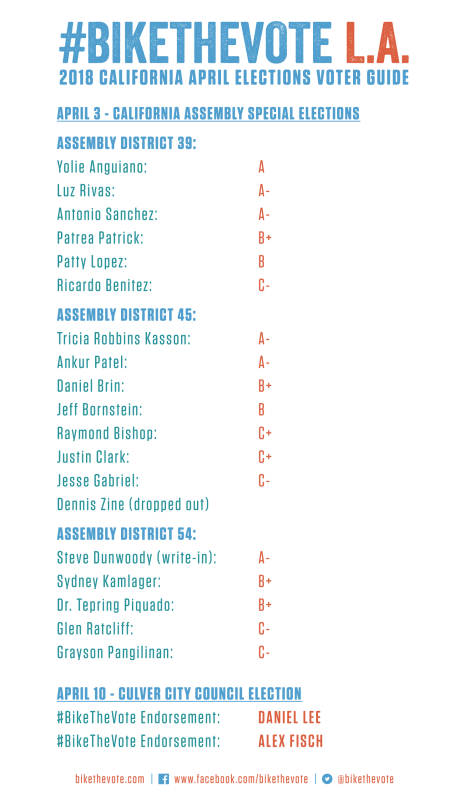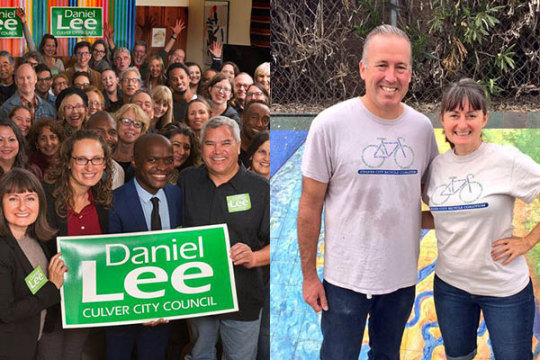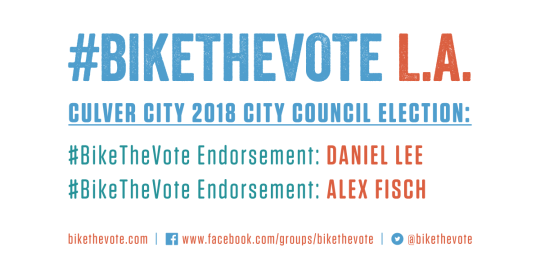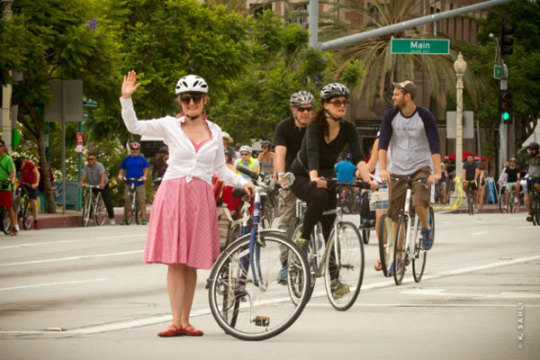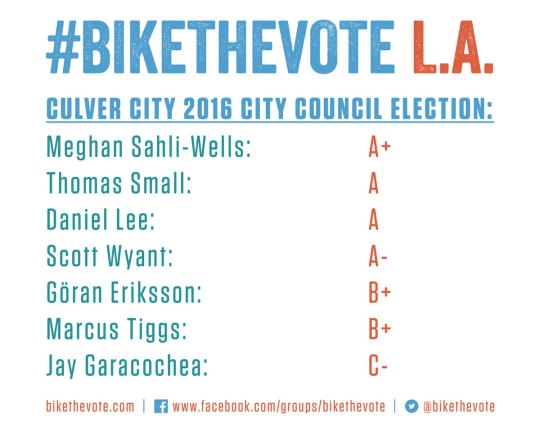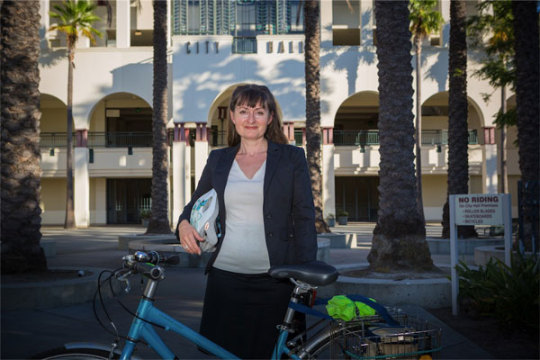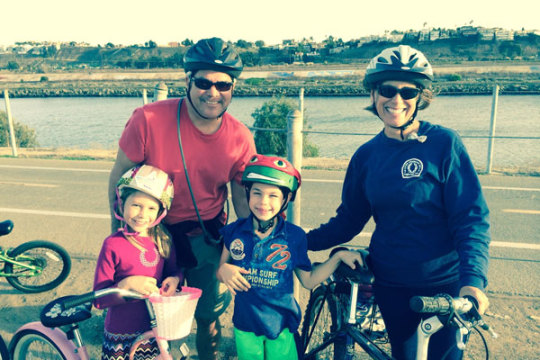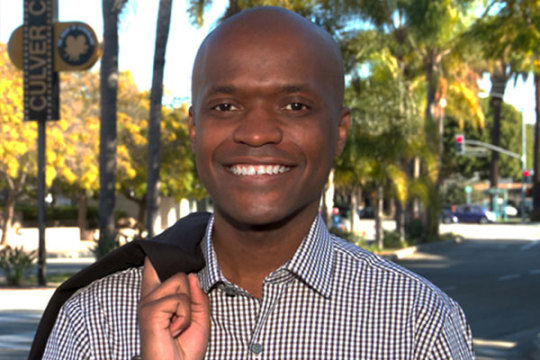As a steering committee member of Bike Culver City, Alex Fisch is no stranger to the livable streets community. His experience as a safe streets advocate and regular bike commuter shines through in his platform on transportation. An ardent supporter of Vision Zero, Fisch articulates a thoughtful, compelling vision of a transportation system centered on walkability and complemented by quality transit and a safe, comfortable bike network for people of all ages and abilities.
Fisch actively participated in Culver City’s recent Transit Oriented Development study, helping to shape the report’s pedestrian and bicycle safety recommendations. Fisch’s experience in listening and communicating to effectively build support is a critical skill that Culver City desperately needs as it works to make its streets safer and more livable for all residents, commuters, and stakeholders. Bike The Vote L.A. wholeheartedly endorses Alex Fisch for Culver City Council.
Alex Fisch Questionnaire Response:
1. What would an ideal transportation system for Culver City consist of? What mode options, considerations for people of different ages and abilities, and innovative features would that transportation system include?
An ideal transportation system would meet the growing demand for places where car ownership is not necessary. Such places maximize individual and community wealth, health, and sustainability. The first step is to focus on walkability, for people of all ages and with respect and consideration for those with mobility-impairments. We must also expand transit and make it more appealing and useful. We need a safe and connected network for people of all ages and confidence levels to travel by bicycle. And we need to use innovative parking and traffic demand management strategies to manage car traffic in ways that minimize impacts to our residential streets. Specifically, we should:
- improve and expand Culver City’s bus system, in part by coordinating with neighboring jurisdictions to create express bus routes, increase connections, and reduce headways;
- continue to invest in the improvement and maintenance of our streets and sidewalks;
- where the potential for walkability is high, expand sidewalks and improve the streetscape as opportunities arise;
- repaint faded crosswalks with high-visibility treatments;
- encourage neighborhoods to work together to develop traffic management plans;
- employ principles of “tactical urbanism” and “lean urbanism” to find innovative solutions to mobility challenges and test them inexpensively;
- increase bike lanes, focusing on creating a clearly marked, interconnected network of safe and inviting bicycle infrastructure;
- install protected bike lanes on high demand routes;
- implement and expand a bike share program; and
- adopt a traffic demand management (TDM) toolkit and implement TDM strategies.
We know that cities that invest in multimodal transportation options are more prosperous and less expensive to maintain, and inspire more creativity and joy, than those that are wholly reliant on the automobile. The cities that provide a variety of safe, useful, comfortable, and interesting ways for people travel will be the cities that prosper in the 21st century.
2. Culver City is currently considering adopting a “Vision Zero” policy to work towards preventing traffic related deaths through roadway design. Do you support Vision Zero? How do you think Culver City should engage with its community of residents and businesses in order to eliminate roadway deaths?
I strongly support Vision Zero. Approximately 37,000 people were killed by cars in the US last year. Nearly 6,000 of those killed were pedestrians. The pedestrians who are killed are disproportionately seniors and children.
Implementing Vision Zero will require a public rejection of this dull drumbeat of preventable deaths and an embrace of safety, sustainability, and livability. We must broadly communicate the connection between design, engineering, education, enforcement, and the weight of loss from roadway deaths. While advocacy groups will always do much of this work, the support of elected officials is essential.
3. Culver City’s Bicycle & Pedestrian Action Plan is well under way as a means of updating the city’s vision and implementation plan for livable streets. What do you hope to see from this plan?
This is the first update of Culver City’s Bicycle & Pedestrian Action Plan. From the experience of the first Plan, I believe that we need broad and deep community engagement to develop a high-quality and actionable updated Plan. Additionally, City Council must be diligent in implementing the Plan.
I hope that the updated plan will prioritize the creation of a network of safe routes connecting residents, visitors, businesses, and high quality transit facilities. For example, building a protected bikeway from the Culver City Expo Line station to the downtown businesses would close a gap in the regional Expo Line bikeway, bring more visitors to downtown Culver City businesses without increasing pollution or car congestion, make bike share exponentially more useful, and provide a safe route for children who currently do not have a convenient way to get to Culver City schools. Additionally, I believe that Fox Hills is underserved and lacks safe and appealing active transportation connections to the rest of Culver City.
4. In November, the final Culver City Transit Oriented Development Visioning Study and Recommendations were released, including recommendations to improve pedestrian and bicycle access to and from transit. What components of this plan do you support, and why?
I attended most of the Visioning Study meetings and, with my neighbors, helped develop pedestrian and bicycle safety recommendations that ultimately were incorporated into the Visioning Study and Recommendations (Report).
There is a checklist of specific components beginning at page 114 of the Report, along with general guidance on the timing and sequencing of, and objectives served by, each recommendation. I agree with most components of the Report, provided that each step is tested and reviewed using objective data, and that the plan is adapted based on real world experience and unforeseen developments.
I strongly support the short term recommendations, which focus on implementing traffic demand management strategies, protecting residential neighborhoods from high speed traffic, establishing a mobility fund to pay for future projects, testing innovative microtransit, and building a protected bikeway between the Expo Line and downtown Culver City.
5. Since the configuration of most of Culver City public roads was set at a time when the primary concern was moving motor vehicles, improving roadway safety will require some tough trade-offs, including reducing speed limits, and reallocating parking and/or travel lanes to make room for safe biking facilities. How will you prioritize public safety, knowing that some stakeholders may complain about reduced vehicle speeds?
Our streets must serve the needs of all users. With robust public outreach and careful implementation, redesigning streets for reduced vehicle speeds and dedicated, separate, safe space for bikes and pedestrians can garner enthusiastic public support. Every road or transit intervention must go through a community outreach process and should involve the Bicycle & Pedestrian Advisory Committee. City staff and advisory committees must work to tailor each project to meet the needs of our businesses and residents. Each project should be analyzed and adjusted as it is implemented and thereafter so that our streets work better over time for all users, and fairly balance everyone’s interests as our overall transportation system evolves.
6. Do you presently bike in Culver City? What are your experiences, or if not, what would it take to make you feel comfortable biking on city streets?
I commute by bike to and from my office in downtown Los Angeles at least once per week, and I regularly complete local trips by bike. I would love to make more trips by bike with my wife and young children. Based on how much fun they have and how far they ride at CicLAvia, I know that more and better bike infrastructure would make that possible.
